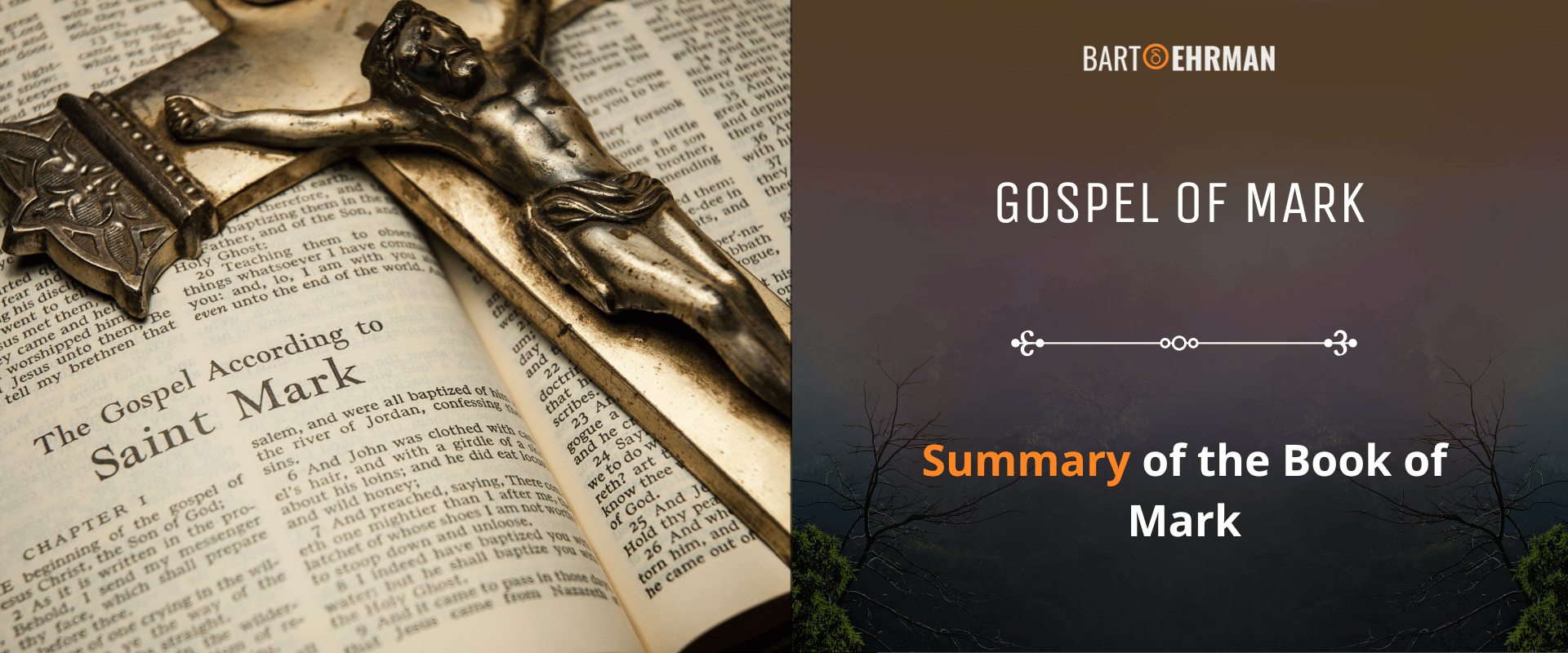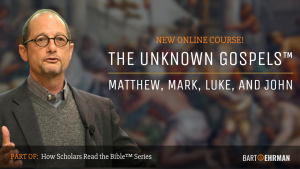Gospel of Mark: Summary of the Book of Mark

Written by Marko Marina, Ph.D.
Author | Historian
Author | Historian | BE Contributor
Verified! See our guidelines
Verified! See our editorial guidelines
Date written: April 3rd, 2024
Edited by Laura Robinson, Ph.D.
Disclaimer: The views and opinions expressed in this article belong to the author and do not necessarily match my own. - Dr. Bart D. Ehrman
Among the Four Gospels of the New Testament, Mark stands as the earliest written, offering a unique and insightful lens through which we can understand the life and teachings of Jesus Christ.
This article embarks on a scholarly yet accessible journey through the Gospel of Mark, aiming to illuminate its major themes, historical context, and the distinct portrayal of Jesus as both Messiah and suffering servant.
As we dissect its passages, our article will also spotlight the major events that punctuate this narrative, setting the stage for a deeper comprehension of its theological and historical layers. Join us as we navigate the depths of this profound narrative, inviting readers to grasp the nuances that make Mark's account a pivotal source for Jesus' life.
Before we delve deeper into the intricacies of the Gospel of Mark, consider enriching your understanding with Dr. Bart D. Ehrman's online course, "The Unknown Gospels." This scholarly exploration challenges us to question the historical reliability of these narratives, distinguishing between fact and fiction. Engage with this critical examination to illuminate your journey through the Gospels.

Who was Mark in the Bible?
Grounding our discussion in the consensus of critical scholars, the following section presents key facts about the Gospel of Mark as a historical source. It offers insights into its authorship, date of writing, intended audience, language, and place of composition.
With these foundational aspects of the Gospel of Mark established, let us delve into the historical milieu that shaped its creation and themes.
Historical Milieu of the Gospel of Mark
Around the year 70 C.E. believers in Jesus were living in a time of great crisis. During the decade of the 60s, some of the movement's leading figures were killed. Christian tradition, for instance, reports that both Peter and Paul were martyred in Rome under Emperor Nero. While we can’t be certain about Peter’s destiny, the tradition of his martyrdom in Rome was firmly grounded in the collective memory of the Church by the end of the first century.
Moreover, multiple sources claim that James the brother of Jesus was stoned to death in Jerusalem. From Paul’s undisputed letters, we also know that Peter and James were important Christian leaders and the loss of these men must have dismayed any Christians who heard the story of their violent death.
Furthermore, the early Christian movement had a significant apocalyptic outlook with a dominant influx of pagan converts. The apostle Paul, for example, expected Jesus to return from heaven to begin the general resurrection and judgment during his lifetime. In the years of Mark’s Gospel, however, Paul was dead and Jesus hadn’t yet returned.
Primarily, Judea and Galilee were afflicted by conflict. Groups among the Jews, like the Zealots, had consistently shown dissatisfaction with the dominion of the Romans (pagans), driven by their conviction that God had designated that territory for the Jewish people. Over time, these tensions intensified.
In the late 60s, a full-scale Jewish revolt emerged to expel the Romans from Judea and Galilee. At first, the Jews found some success but eventually Roman reinforcements arrived, and by the year 70 C.E., the Romans were near the final victory.
They besieged Jerusalem whose residents suffered from famine and widespread destruction. Eventually, the Romans took the city and destroyed its temple. As the war went on, Jewish believers in Jesus found their loyalty to their ethnic group challenging. According to the Church father Eusebius, some in and near Jerusalem even fled.
It was against this backdrop of war, loss, and apocalyptic expectation that the Gospel of Mark was written, providing the earliest surviving account of Jesus’ ministry and death. With this tumultuous historical setting as our backdrop, we now transition to examine how Jesus is portrayed in the Gospel of Mark, focusing on the major themes that underscore his unique identity and mission.
FREE COURSE!
WHY I AM NOT A CHRISTIAN
Raw, honest, and enlightening. Bart's story of why he deconverted from the Christian faith.
Over 6,000 enrolled!
The Book of Mark: Jesus and the Main Themes
We have to remember that each Gospel writer presents a distinct perspective on Jesus, tailoring their narrative to highlight unique emphases and themes that illuminate their understanding of His identity and mission. By looking at Mark’s themes, we gain one interesting perspective most certainly motivated by the author’s social and theological concerns.
Historians disagree whether Mark wrote shortly after the temple was destroyed or shortly before when it could easily have been anticipated. In any case, Mark proclaims the good news about Jesus for believers who are under stress; believers who are witnessing their world spinning in suffering and death.
The Kingdom of God
The proclamation of the Kingdom of God stands as one of the most fundamental themes in the Gospel of Mark, marking the very onset of Jesus' public ministry with a clear and explicit call: "The time is fulfilled, and the kingdom of God is at hand; repent and believe in the gospel (1:15).”
Contrary to expectations of a distant, heavenly realm, Mark depicts the Kingdom as a tangible reality, imminent and earthly, poised to transform the world within the lifetimes of his audience. This sense of urgency is underscored by Jesus' assurance, "Truly I tell you, some who are standing here will not taste death before they see that the kingdom of God has come with power" (Mark 9:1).
It's one of the most notable Jesus' sayings emphasizing that the coming Kingdom wasn’t a far-off dream but a near and pressing reality, expected to unfold within "this generation." It’s a message deeply embedded within the Jewish apocalyptic expectations.
My students often assume that the theme of God’s kingdom in Mark is related to some distant future or a heavenly realm.
But the historical context of the Jewish apocalyptic world is clear. James Goldstein notes: The authors of Israelite prophecy were seldom if ever interested in the remote future, and the audiences who preserved their works were chiefly interested in the present and in a future that included little if any more than their lifetimes.”
How is Jesus Portrayed in the Gospel of Mark: The Theme of Secrecy
Mark’s main message presented through Jesus is clear: The Kingdom of God is indeed at hand. Current events prove it! In these days of tribulation, suffering and death are what believers can anticipate. However, by suffering they are imitating Jesus because his mission, as the Son of God, was, according to Mark, to suffer and die for others.
Mark conveys this message through another important theme that scholars call the Messianic secret. As Mark tells it, the characters in the narrative that should recognize Jesus’ true identity and mission (disciples like Peter and James) don’t. Instead, they consistently misunderstand Jesus and what being his disciple means. On the other hand, only marginal characters recognize and accept Jesus' true identity and mission.
When reading the Gospel of Mark, we must remind ourselves that the other Gospels (Matthew, Luke, and John) didn’t yet exist! Consequently, we have to be careful not to import into his narrative what we find in theirs! Mark, for instance, doesn’t have the birth narrative at all.
In the Gospel of Mark, Jesus appears as a full-grown man from Nazareth. The first major event in his life is the baptism at the Jordan River. Mark tells us that when he came out of the water Jesus saw the heavens open and the Spirit descending on him like a dove.
A voice told him: “You are my Son, whom I love; with you, I am well pleased (Mk 1:11).” It’s important to note who sees this happen and to whom the voice speaks! Jesus is the only one who sees the openings of heaven and the descent of the Spirit. Furthermore, the voice addresses only Jesus. In other words, Mark presents this as a private revelation for Jesus alone.
This theme of concealment of Jesus' identity and mission continues as he begins his ministry!
When he casts out a demon, the demon says to him: “I know who you are, the holy one of God (1:24)." However, Jesus warns the demon to be quiet before casting him out! Mark even tells us (1:34) that Jesus cast out many demons and he wouldn’t permit them to speak because they knew him and who he was.
Mark also has Jesus delivering a series of parables so that other people (outsiders) won’t understand him. In Mk 4:11-12, he says to the disciples: “The secret of the kingdom of God has been given to you. But to those on the outside everything is said in parables so that they may be ever seeing but never perceiving, and ever hearing but never understanding; otherwise they might turn and be forgiven!”
In this case, Jesus suggests that the disciples do know something that others don’t - the secret of the Kingdom of God that would soon arrive. However, elsewhere the disciples seem clueless about his true identity.
After he stills a storm on the sea (4:35-41), the disciples ask one another who then is this that even the wind and sea obey him? Later, Jesus feeds 5,000 people with five loaves and two fishes and then he walks on water. However, Mark tells us that the disciples were utterly astounded. They didn't understand this miracle; "their hearts were hardened" (6:52).
Finally, one of the disciples (Peter) does figure out who Jesus is. He declares to Jesus: You are the Messiah (8:29).” Yet, Jesus, as Mark says, sternly ordered them not to tell anyone about him and his true identity.
One can easily observe the main thematic pattern in the Gospel of Mark:
That is what scholars call the “Messianic Secret” in the Book of Mark. How should we understand this theme? Why does Mark depict Jesus as hiding his true identity?
The first scholar who recognized this theme was William Wrede who in 1901 published the book “The Messianic Secret”. He proposed a brilliant explanation: Mark used the messianic secret theme to solve a historical problem.
On the one hand, since Jesus’ crucifixion, his followers had been proclaiming him the Messiah and the Son of God.
On the other hand, Wrede argued that the historical Jesus never actually made this claim about himself. Mark solves this contradiction by having Jesus acknowledge his messianic and divine identity during his lifetime, but command people to keep it a secret until after his death.
The Gospel of Mark and Jesus as the Suffering Servant
Having established Jesus as the Messiah and Son of God, we now explore a pivotal aspect of Mark's portrayal: the nature of Jesus' messiahship, characterized by a path of suffering that challenges and deepens Mark's understanding of Jesus' divine mission.
We can get a better appreciation for Mark’s portrayal of Jesus by looking closely at what the disciples seem to understand about Jesus and who understands him the best. When we choose that path, we soon reveal that Mark’s main emphasis is that Jesus’ mission was to suffer and die.
In other words, a major theme in Mark’s Gospel is Jesus as the Suffering servant. Bart D. Ehrman explains: “Throughout the early portions of Mark’s Gospel, the reader is given several indications that Jesus will have to die… Even though he is the Christ, the Son of God - or rather because he is - he must suffer death.”
On three separate occasions, Jesus predicts his suffering destiny:
In a nutshell, Jesus is portrayed in the Gospel of Mark as the Son of Man, the Messiah who came to suffer, die, and rise again! His followers must likewise serve others and be willing to suffer and die. This is what the disciples, according to Mark, have failed to see.

The Book of Mark: Outlining the Key Events
After a closer look at the main themes of the Gospel of Mark, we turn our focus to the pivotal events that form the backbone of this narrative. These events offer profound insights into His teachings and the nature of His ministry.
Belonging to the genre of ancient biography, Mark’s Gospel presents a chronological outlook of Jesus' life, focusing extensively on His public ministry and death. As it turns out, the largest portion of the Gospel of Mark is related to Jesus’ last week.
a) Baptism and Temptation of Jesus
Mark introduces us to Jesus' ministry starting with His baptism by John the Baptist, signifying the beginning of His divine mission, followed by His temptation in the wilderness. This sequence underscores Jesus' readiness to embrace His calling and the spiritual fortitude He possessed to withstand the challenges ahead.
Referring to the temptations as described in the Book of Mark, Mary Healy notes: "Jesus enters into Satan’s territory deliberately, to begin his campaign against the powers of evil. He is looking for a fight! Yet he will confront Satan not with a blast of divine lightning, but in his frail human nature, empowered by the Spirit."
b) The Calling of the Disciples
Jesus' invitation to the fishermen, "Come, follow me, and I will send you out to fish for people (1:17)", marks a significant moment. This event not only signifies the formation of Jesus' inner circle but also illustrates the concept of radical discipleship — a call to abandon the familiar for a life devoted to spreading the Gospel.
c) Jesus’ miracles and teachings
Mark's narrative is replete with accounts of miracles — healings, exorcisms, and control over nature — each underscoring Jesus' authority and compassion. His teachings revolving around the main theme of the Kingdom of God call people to repent for their sins and prepare for Judgment Day.
d) Passion Week (Triumphal Entry, Last Supper, Crucifixion, and Resurrection)
The culmination of Mark's Gospel, these events narrate the final week of Jesus' earthly ministry. From His triumphant entry into Jerusalem, symbolizing His kingly status, to the intimacy of the Last Supper, where Jesus establishes a new covenant, and through to the suffering of the crucifixion — Mark presents these moments within his overall theme of the Messiah who has to suffer and die to redeem others. For Mark, Jesus' death was an atonement for sin.
Interestingly enough, Bart D. Ehrman has argued that this core idea (Jesus’ death as an atonement) is strangely absent in the Gospel of Luke! For more on his arguments, see this article. In any case, his observation warns us that we shouldn’t read into Mark’s narrative elements from other New Testament Gospels.
Each Gospel has its unique perspective and emphasis which brings us to the last section of our article: the biggest oddity in the Gospel of Mark!
The Gospel of Mark: Strange Ending?
The inability to understand Jesus’ true identity and mission is also extended to his female disciples in the Book of Mark. When they discover that Jesus’ tomb is empty, a young man tells them that Jesus has risen from the dead. He orders the women to go and announce the great news to the other disciples.
You would think that they would run away as fast as they could screaming that Jesus conquered death! However, Mark writes: “When they heard, they fled and went out from the tomb, for shock and trembling had seized them and they said nothing to anyone, for they were afraid (16:8).”
This is how the original Gospel of Mark ended! In other words, women failed to do what the young man had told them. There are no appearances of the risen Jesus! This ending was so unsatisfactory that later Christians added several possible endings to the gospel. Most modern Bible versions keep alternative endings in their translations noting that they don't belong to the original Gospel of Mark.
How do we know that abrupt ending was how Mark finished his narrative? There are, of course, no certainties. However, several indicators serve as strong arguments in favor of that conclusion:
In his captivating bestseller Misquoting Jesus, Bart Ehrman concludes: “In short, the evidence is sufficient to convince nearly all textual scholars that these verses are an addition to Mark.”
The Gospel of Mark Summary and the Concluding Remarks
In concluding our scholarly journey through the Gospel of Mark, we arrive at the core inquiry: What is Mark about? At its essence, The Book of Mark is a complex, nuanced narrative that offers an early, distinct perspective on the life, mission, and teachings of Jesus Christ.
Unlike the synoptic counterparts—Matthew and Luke—Mark presents a Jesus who embodies both the power of the Messiah and the vulnerability of the suffering servant, a duality that speaks to the heart of the Christian message.
Mark’s narrative, set against the backdrop of Jewish apocalyptic expectations and the tumultuous socio-political landscape of 1st-century Judea, serves not only as a theological treatise but also as a pastoral response to a community in crisis.
By highlighting themes such as the Kingdom of God, the messianic secret, and Jesus’ role as the suffering servant, Mark addresses the immediate concerns and hopes of his audience, urging them towards faith and perseverance amid suffering and uncertainty.
The Gospel of Mark summary is all about the unveiling of God’s kingdom through Jesus Christ, who, as both Messiah and suffering servant, inaugurates a new era of redemption and calls his followers to radical discipleship characterized by service, sacrifice, and steadfast proclamation of the good news.

